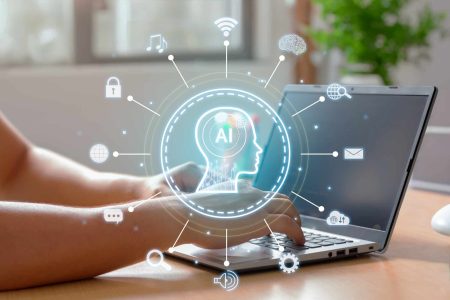Artificial Intelligence (AI) has rapidly transformed various industries, and at the heart of many AI systems lies the concept of agents. Understanding what an AI agent is and how it functions is crucial for grasping the broader scope of AI technology. This guide delves into the different types of agents in AI, exploring their unique roles within AI systems. We will examine the architecture and design principles that underpin these agents, distinguishing between reactive and deliberative agents to highlight their distinct operational approaches. The guide will also cover the diverse applications of AI agents across multiple fields, while addressing the challenges faced in their development. Additionally, we will discuss the ethical considerations that arise with the deployment of AI agents and look ahead to future trends that may shape their evolution. Finally, we will summarize the key takeaways to provide a comprehensive understanding of AI agents.
Content
Introduction to AI Agents
Defining AI Agents
AI agents are autonomous entities that observe their environment, make decisions, and perform actions to achieve specific goals. These agents can range from simple rule-based systems to complex learning models capable of adapting to new situations. At their core, AI agents are designed to interact with their surroundings in a way that mimics human decision-making processes. They gather data through sensors, process this information using algorithms, and execute actions that are intended to meet predefined objectives. Understanding the definition of AI agents is the first step in appreciating their capabilities and potential applications.
Historical Background
The concept of AI agents has evolved significantly since its inception. Early AI systems were primarily rule-based, relying on predefined instructions to perform tasks. These rudimentary agents laid the groundwork for more sophisticated models that incorporate machine learning and artificial neural networks. Over the decades, advancements in computational power and algorithmic complexity have enabled the development of agents that can learn from experience and improve their performance over time. This historical progression highlights the continuous innovation in the field of AI, driven by the quest to create more intelligent and autonomous systems.
Basic Components of AI Agents
AI agents are composed of several fundamental components that work together to enable autonomous decision-making. The primary components include sensors, actuators, and a processing unit. Sensors gather data from the environment, providing the agent with the necessary information to make informed decisions. The processing unit, often powered by sophisticated algorithms and machine learning models, interprets this data and determines the best course of action. Actuators then execute the chosen actions, allowing the agent to interact with its environment. These components collectively enable AI agents to function effectively, making them versatile tools in various applications.
Types of Agents in AI
Simple reflex agents operate based on a set of predefined rules and conditions. These agents respond directly to percepts from their environment without considering the history of previous percepts. They are designed to execute specific actions when particular conditions are met, making them highly efficient for straightforward tasks. However, their lack of memory and adaptability means they are limited to environments where the rules are well-defined and static. Despite these limitations, simple reflex agents are widely used in applications where quick, rule-based responses are sufficient, such as automated customer service bots and basic game AI.
Model-based reflex agents extend the capabilities of simple reflex agents by incorporating a model of the world. This model allows the agent to maintain an internal state, providing context for its actions. By understanding how the world evolves and how its actions affect the environment, a model-based reflex agent can make more informed decisions. This type of agent is particularly useful in dynamic environments where conditions change over time. For example, in robotic navigation, a model-based reflex agent can update its internal map of the surroundings as it moves, enabling it to navigate more effectively.
Goal-based agents take the concept of internal state a step further by incorporating goals into their decision-making process. These agents not only consider the current state of the environment but also evaluate potential future states to achieve their objectives. By using search and planning algorithms, goal-based agents can determine the sequence of actions that will lead to the desired outcome. This makes them suitable for complex tasks requiring long-term planning and adaptability, such as autonomous driving and strategic game playing. Goal-based agents represent a significant advancement in AI, as they can handle uncertainty and make decisions that align with overarching goals.
Role of Agents in AI Systems
Decision-Making
AI agents play a crucial role in decision-making processes within AI systems. They are designed to analyze vast amounts of data, recognize patterns, and make informed decisions based on predefined criteria or learned experiences. By leveraging complex algorithms and machine learning models, these agents can evaluate multiple variables simultaneously, optimizing outcomes in real-time. This capability is particularly valuable in environments where quick and accurate decisions are essential, such as financial trading, healthcare diagnostics, and autonomous vehicles. The decision-making prowess of AI agents enables them to perform tasks that would be challenging or time-consuming for humans, thus enhancing efficiency and effectiveness across various domains.
Automation
One of the primary roles of AI agents in AI systems is to automate repetitive and mundane tasks. By taking over routine operations, AI agents free up human resources to focus on more complex and creative endeavors. Automation powered by AI agents is prevalent in industries like manufacturing, where robots handle assembly line tasks, and in customer service, where chatbots manage initial customer interactions. These agents can operate continuously without fatigue, ensuring consistent performance and reducing the likelihood of errors. The ability to automate processes not only increases productivity but also allows organizations to scale their operations more effectively, meeting growing demand without a proportional increase in labor costs.
Adaptation and Learning
AI agents are integral to the adaptive and learning capabilities of AI systems. Unlike static systems, adaptive agents can learn from their interactions with the environment and improve their performance over time. Through techniques such as reinforcement learning, these agents adjust their strategies based on feedback, optimizing their actions to achieve better results. This adaptability is crucial in dynamic environments where conditions are constantly changing, such as in cybersecurity, where agents must continuously evolve to counter new threats. The learning aspect of AI agents ensures that they remain relevant and effective, providing long-term value by continually enhancing their capabilities and adapting to new challenges.
Transform your business with custom AI solutions from a leading Artificial Intelligence Agency.
Agent Architecture and Design
The architecture of an AI agent is fundamental to its functionality and performance. At its core, an AI agent’s architecture comprises several key components: sensors, actuators, a processing unit, and a memory system. Sensors are responsible for collecting data from the environment, which is then processed by the agent’s algorithms to make informed decisions. The actuators execute these decisions by performing actions in the environment. The memory system allows the agent to store and retrieve information, which is crucial for learning and adapting over time. This modular design ensures that each component can be optimized and upgraded independently, enhancing the overall versatility and efficiency of the agent.
Designing an AI agent involves selecting the appropriate algorithms and models that align with the agent’s intended tasks and goals. For instance, a simple reflex agent might rely on basic rule-based algorithms, while a more complex, goal-based agent could utilize advanced machine learning techniques. The choice of algorithms significantly impacts the agent’s ability to process information, learn from experiences, and make decisions. Additionally, the design process must consider the computational resources available, as more sophisticated models often require greater processing power and memory. Balancing these factors is essential to create an agent that is both effective and efficient in its operational context.
Scalability and robustness are critical considerations in the architecture and design of AI agents. Scalability ensures that the agent can handle increasing amounts of data and more complex tasks as the system evolves. This often involves designing the agent to be modular, allowing for the integration of new functionalities without overhauling the entire system. Robustness, on the other hand, refers to the agent’s ability to perform reliably under varying conditions and in the face of unexpected challenges. This can be achieved through rigorous testing and the implementation of fail-safes and redundancy measures. By prioritizing scalability and robustness, designers can ensure that AI agents remain effective and dependable, even as they are deployed in increasingly demanding environments.
Experience effortless, cost-effective social media management with AI technologies
Reactive vs. Deliberative Agents
Characteristics of Reactive Agents
Reactive agents are designed to respond immediately to changes in their environment based on predefined rules or patterns. They do not maintain an internal state or history of past interactions, making their decision-making process straightforward and efficient. This simplicity allows reactive agents to operate with minimal computational resources, making them suitable for real-time applications where speed is crucial. For example, reactive agents are commonly used in video games to control non-player characters (NPCs) that need to react quickly to player actions. However, the lack of memory and foresight limits their ability to handle complex tasks that require long-term planning or adaptation to changing conditions.
Characteristics of Deliberative Agents
Deliberative agents, in contrast, maintain an internal model of the world and use this model to make informed decisions. They consider both current and past information to plan future actions, allowing for more sophisticated and adaptive behavior. Deliberative agents employ various algorithms, such as search and planning techniques, to evaluate potential actions and select the most appropriate one to achieve their goals. This capability makes them suitable for complex tasks that require strategic thinking and long-term planning, such as autonomous navigation and strategic game playing. However, the complexity of deliberative agents often demands significant computational resources and processing time, which can be a limitation in real-time or resource-constrained environments.
Comparative Advantages and Disadvantages
The choice between reactive and deliberative agents depends on the specific requirements of the application. Reactive agents excel in environments where quick, rule-based responses are needed and where computational resources are limited. Their simplicity and efficiency make them ideal for tasks that do not require long-term planning or adaptation. On the other hand, deliberative agents are better suited for complex, dynamic environments where strategic planning and adaptability are essential. They can handle uncertainty and make decisions that align with overarching goals, but this comes at the cost of increased computational demands. Understanding the comparative advantages and disadvantages of each type helps in selecting the appropriate agent architecture for a given task, balancing the need for speed, complexity, and resource availability.
Applications of AI Agents
AI agents are revolutionizing the healthcare industry by enhancing diagnostic accuracy and personalizing patient care. In medical diagnostics, AI agents analyze vast datasets, including medical images and patient records, to identify patterns and anomalies that might be overlooked by human practitioners. These agents assist in early detection of diseases such as cancer, enabling timely intervention and improving patient outcomes. Additionally, AI agents are used in personalized medicine to tailor treatment plans based on individual patient data, including genetic information and lifestyle factors. This level of customization leads to more effective treatments and reduced side effects, showcasing the transformative potential of AI in healthcare.
In the financial sector, AI agents are employed to optimize trading strategies and manage risk. High-frequency trading firms use AI agents to analyze market data in real-time and execute trades at speeds unattainable by human traders. These agents leverage machine learning algorithms to predict market movements and identify profitable trading opportunities. Furthermore, AI agents are instrumental in fraud detection and prevention. By continuously monitoring transactions and identifying suspicious patterns, these agents help financial institutions mitigate risks and protect their clients from fraudulent activities. The ability of AI agents to process large volumes of data quickly and accurately makes them invaluable assets in the fast-paced world of finance.
AI agents are also making significant strides in the field of autonomous vehicles. Self-driving cars rely on a network of AI agents to navigate complex environments, make real-time decisions, and ensure passenger safety. These agents process input from various sensors, such as cameras, lidar, and radar, to create a detailed understanding of the vehicle’s surroundings. They then use this information to plan routes, avoid obstacles, and respond to dynamic changes in traffic conditions. The collaborative efforts of multiple AI agents enable autonomous vehicles to operate efficiently and safely, reducing the likelihood of accidents and traffic congestion. As the technology continues to advance, AI agents will play an increasingly critical role in the widespread adoption of autonomous transportation.
Elevate your business with DIGITALON AI’s custom AI services and solutions.
Challenges in Developing AI Agents
Data Quality and Availability
One of the primary challenges in developing AI agents is ensuring the quality and availability of data. AI agents rely heavily on large datasets to learn and make decisions, but accessing high-quality, relevant data can be difficult. Incomplete, biased, or noisy data can significantly impair the performance of AI agents, leading to inaccurate or unreliable outcomes. Additionally, data privacy concerns and regulatory restrictions often limit access to crucial data, further complicating the development process. Developers must invest considerable effort in data preprocessing, cleaning, and augmentation to create robust datasets that can train AI agents effectively. Addressing these data-related challenges is essential for building reliable and accurate AI systems.
Computational Resources
Developing sophisticated AI agents often requires substantial computational resources, including powerful processors, large memory capacities, and specialized hardware like GPUs and TPUs. Training complex models, especially those involving deep learning, can be computationally intensive and time-consuming. This demand for high computational power can be a significant barrier for smaller organizations or research groups with limited resources. Additionally, the energy consumption associated with training large AI models raises environmental concerns. Balancing the need for advanced computational capabilities with resource constraints and sustainability considerations is a critical challenge in the development of AI agents. Efficient algorithms and optimization techniques are essential to mitigate these issues.
Ethical and Bias Concerns
Ethical considerations and bias are significant challenges in the development of AI agents. AI systems can inadvertently perpetuate or even exacerbate existing biases present in the training data, leading to unfair or discriminatory outcomes. For instance, biased data in hiring algorithms can result in unfair hiring practices, while biases in facial recognition systems can lead to misidentification. Ensuring that AI agents operate fairly and ethically requires developers to actively identify and mitigate biases throughout the development process. This includes implementing fairness-aware algorithms, conducting thorough bias audits, and fostering transparency and accountability. Addressing these ethical challenges is crucial to building AI agents that are not only effective but also socially responsible and trustworthy.
Ethical Considerations for AI Agents
The deployment of AI agents raises significant ethical considerations, particularly concerning privacy and data security. AI agents often require access to vast amounts of personal data to function effectively, which can lead to potential breaches of privacy if not managed responsibly. Ensuring that data is collected, stored, and processed in compliance with stringent privacy regulations is essential to protect individuals’ rights. Additionally, robust encryption and security measures must be implemented to safeguard data against unauthorized access and cyberattacks. Transparency in data handling practices and obtaining explicit consent from users can further enhance trust and mitigate privacy concerns.
Another critical ethical issue is the potential for bias and discrimination in AI agents. AI systems are only as unbiased as the data they are trained on, and if this data contains historical biases, the AI agents can perpetuate and even amplify these biases. This can lead to unfair treatment in various applications, such as hiring, lending, and law enforcement. Developers must actively work to identify and mitigate biases by using diverse and representative datasets, implementing fairness-aware algorithms, and conducting regular bias audits. Ensuring that AI agents operate equitably is crucial to prevent discrimination and promote fairness in their applications.
The ethical use of AI agents also involves considerations of accountability and transparency. As AI agents become more autonomous, determining who is responsible for their actions becomes increasingly complex. Clear guidelines and frameworks need to be established to assign accountability for decisions made by AI agents, especially in critical areas like healthcare and autonomous driving. Transparency in AI systems, including explainable AI techniques, can help stakeholders understand how decisions are made, fostering trust and enabling better oversight. By addressing these ethical considerations, developers can create AI agents that not only perform effectively but also align with societal values and ethical standards.
Future Trends in AI Agents
Advancements in Reinforcement Learning
Reinforcement learning (RL) is poised to play a pivotal role in the future of AI agents. RL enables agents to learn optimal behaviors through trial and error, guided by rewards and penalties. Recent advancements in RL algorithms are making it possible for AI agents to tackle increasingly complex tasks, from mastering intricate games to optimizing industrial processes. Future developments are expected to enhance the efficiency and scalability of RL, allowing agents to learn faster and more effectively in real-world environments. Additionally, integrating RL with other AI techniques, such as deep learning and natural language processing, will further expand the capabilities of AI agents, enabling them to perform more sophisticated and context-aware actions.
Integration with IoT
The integration of AI agents with the Internet of Things (IoT) is set to revolutionize various industries by creating smarter, more interconnected systems. AI agents can process and analyze data from a multitude of IoT devices, enabling real-time decision-making and automation. In smart homes, for instance, AI agents can optimize energy usage, enhance security, and provide personalized user experiences by learning from residents’ behaviors. In industrial settings, AI agents can monitor equipment, predict maintenance needs, and optimize production processes, leading to increased efficiency and reduced downtime. As IoT devices become more ubiquitous, the synergy between AI agents and IoT will drive significant advancements in automation and intelligent system management.
Ethical AI and Explainability
As AI agents become more integrated into daily life, there is a growing emphasis on ethical AI and explainability. Future trends will likely focus on developing AI agents that are not only effective but also transparent and accountable. Explainable AI (XAI) techniques aim to make the decision-making processes of AI agents more understandable to humans, fostering trust and enabling better oversight. Additionally, there will be increased efforts to ensure that AI agents operate fairly and without bias, adhering to ethical guidelines and regulations. By prioritizing ethical considerations and explainability, the development of AI agents will align more closely with societal values, ensuring that these technologies benefit all stakeholders responsibly and equitably.
Conclusion and Key Takeaways
AI agents are rapidly transforming various sectors by enhancing decision-making, automating tasks, and adapting to dynamic environments. From healthcare diagnostics to financial trading and autonomous vehicles, AI agents are proving to be invaluable tools that improve efficiency and accuracy. Their ability to process vast amounts of data in real-time and make informed decisions enables them to tackle complex problems that were previously beyond human capability. As AI agents continue to evolve, their applications will expand, offering even more innovative solutions across different industries.
However, the development and deployment of AI agents come with significant challenges that must be addressed to ensure their effectiveness and ethical operation. Issues such as data quality, computational resource demands, and ethical concerns like bias and accountability are critical factors that developers need to consider. Ensuring that AI agents are built on robust, high-quality data and designed to operate transparently and fairly is essential for their long-term success and societal acceptance. Addressing these challenges requires ongoing research, collaboration, and adherence to ethical guidelines.
Looking ahead, the future of AI agents is promising, with advancements in reinforcement learning, integration with IoT, and a focus on ethical AI and explainability. These trends will drive the development of more sophisticated, efficient, and responsible AI agents capable of operating in increasingly complex and interconnected environments. By prioritizing ethical considerations and leveraging cutting-edge technologies, developers can create AI agents that not only perform effectively but also align with societal values and contribute positively to various fields. The continuous evolution of AI agents will undoubtedly bring about transformative changes, making it imperative to stay informed and engaged with the latest developments in this rapidly advancing domain.























